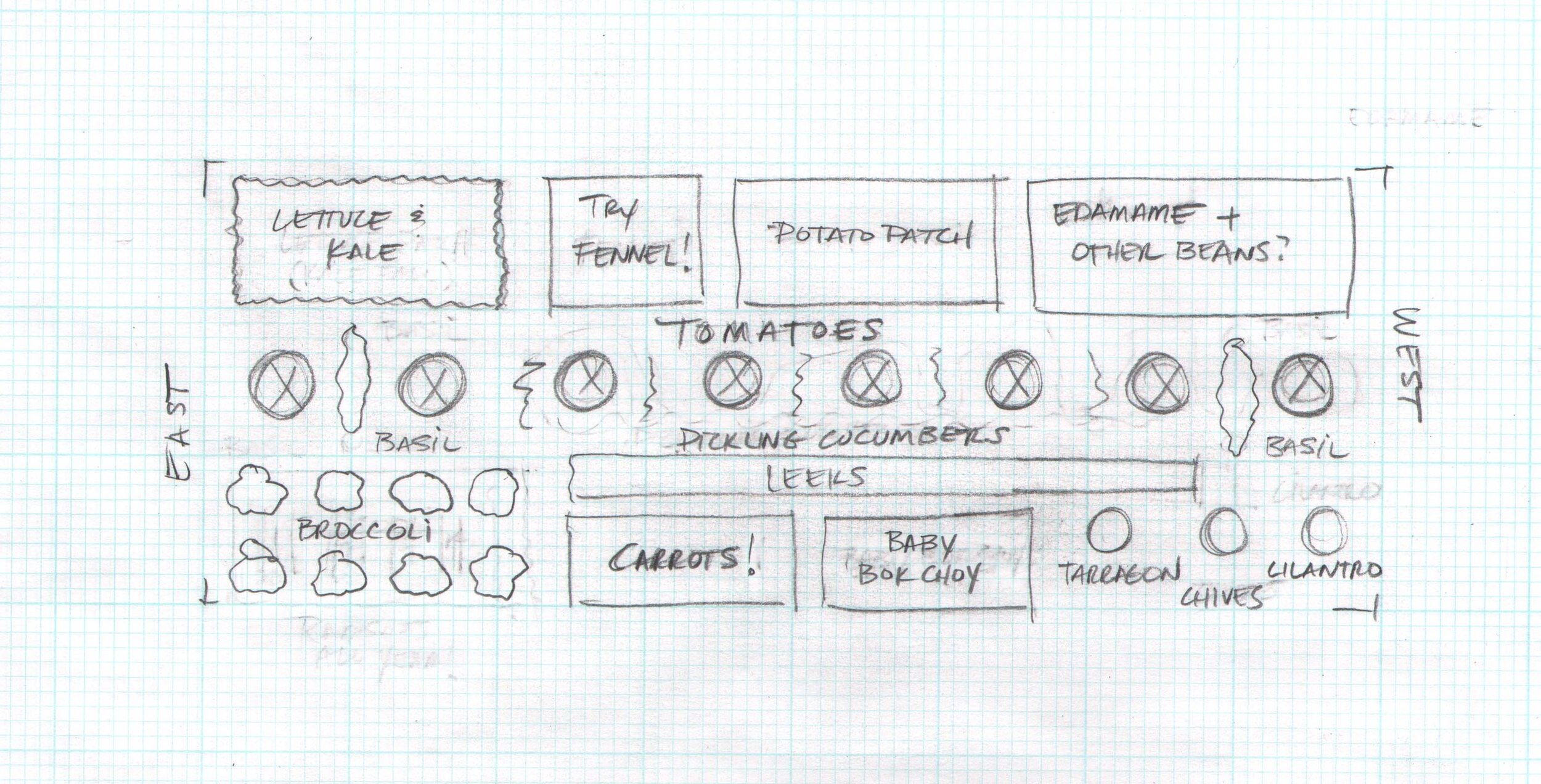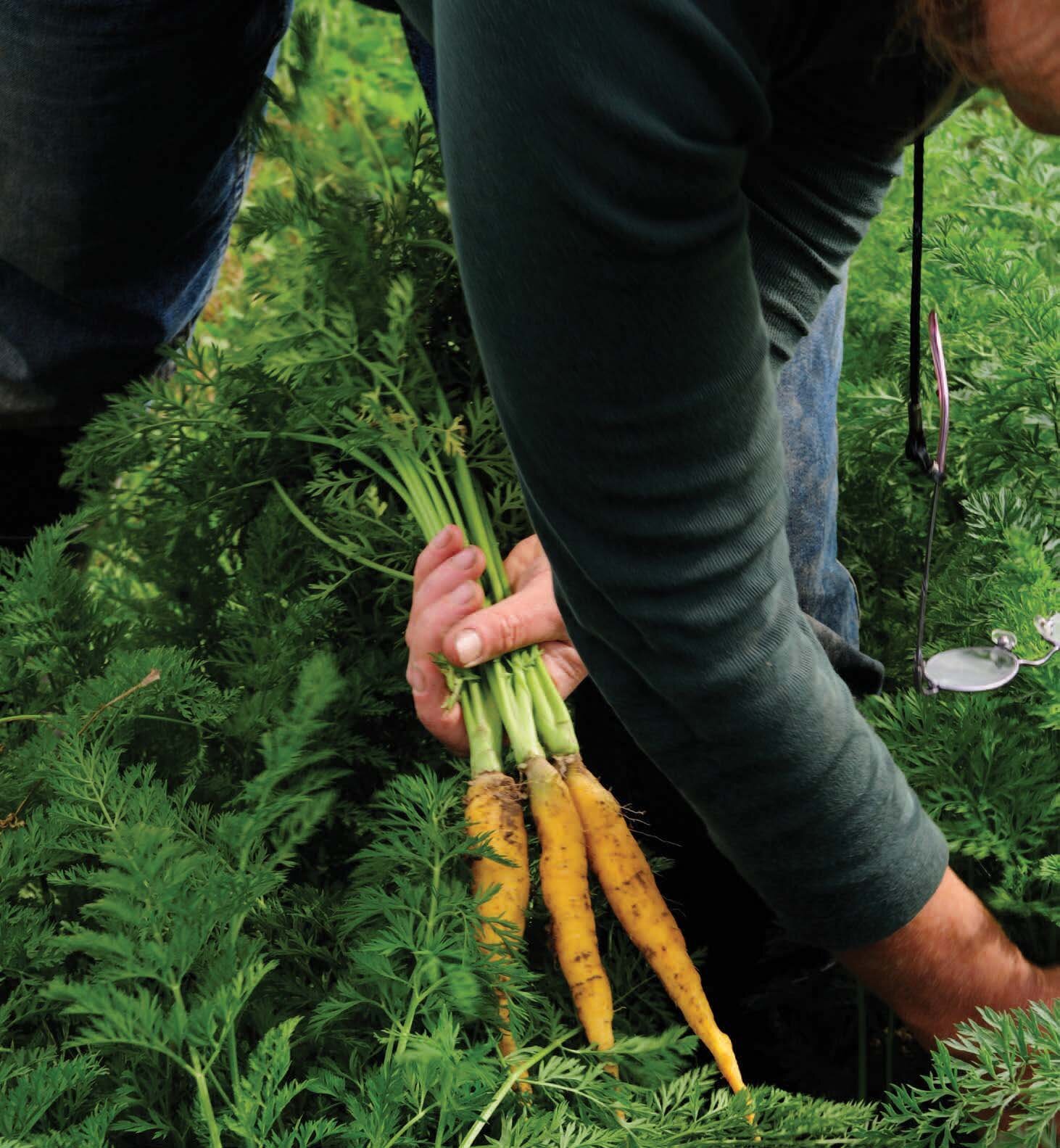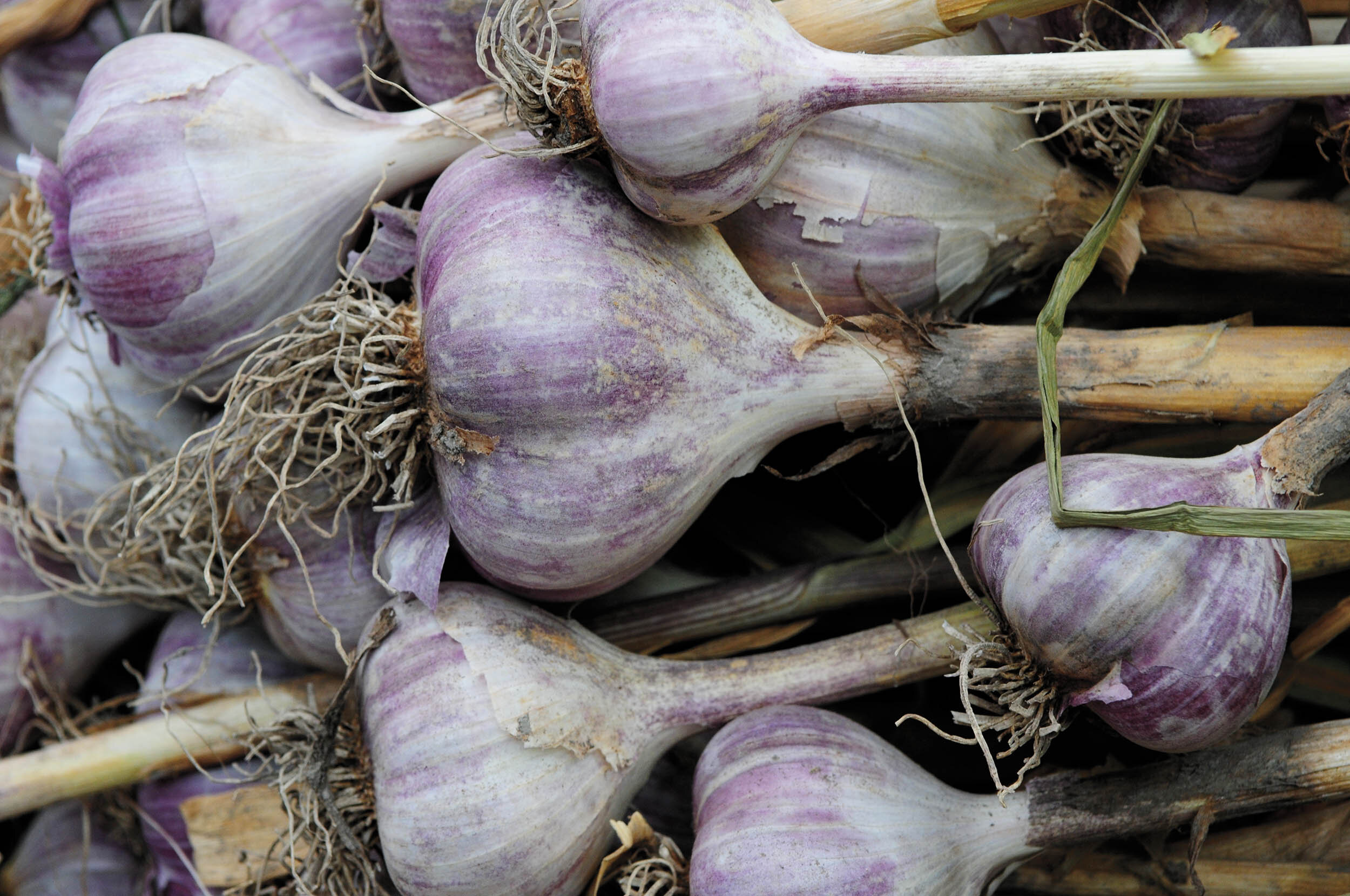The Winter Garden

The first batch of seed catalogs sits stacked on my dining room table. Their arrival in my mailbox is as happy as the Christmas mornings of my childhood: glorious wrappings bursting with color and life, promising hours and hours of blissful enjoyment, right smack in the middle of a green-deprived season.
I spend a fair amount of mental energy in the winter daydreaming about the upcoming growing season. As October wraps up, I might be found grumbling about needing a break from the outdoors, giving lip service to looking forward to easy winter gardening tasks, but by the time December hits, I’m outside once again, wandering around my various garden plots, hovering protectively over the winter crops — carrots, parsnips, leeks, saffron, and herbs. A second-season planting of fingerling potatoes last July means a small cachet of tubers whenever the ground is diggable (whatever potatoes I inadvertently leave behind will come alive again in the spring and sprout anew). Even fennel hung tight this year, deep into December, and broccoli lasted well past the third or fourth hard freeze. It’s been a great winter harvest.
A warmish stretch in early November kickstarted the shallots and garlic that I planted in October — slender green sprouts dot the thick spread of chopped leaves that cover and insulate the garden bed. If normal winter weather holds — turning cold and blustery with the new year — they’ll recede back until late March, when the true seasonal warm-up begins.
Until then, there is much to do on behalf of my four-season garden, although it’s more mental work than physical. I spend January planning and purchasing seeds and transplants, all the while dog-earring pages in the seed catalogs. February and March is devoted to indoor seed starting, while the thaw of late March/early April welcomes spring — at last! — and the first of the season’s outdoor plantings.
Plan and Prepare
Although we typically think of early spring, my summer garden plan revolves completely around my tomato crops. Tomatoes are my gardening crush, my first love, my neverending obsession. Everything else — no matter how deep my fondness for it — gives way to the tomato plant.
This is quite common among my home gardening friends, who began gardening because they wanted to grow their favorite vegetable, whatever that might be. I’ll boldly extrapolate that to home gardeners everywhere: few hobby growers plan their entire garden around crops they don’t like (I’m amarket, where I would show bias to items that sell well).
If you want to start a garden this year, don’t feel pressure to grow things you don’t want to grow. If you love cucumbers, learn everything you can about their growing requirements, and just plant cucumbers. (It’s a good rule for life: discover what gives you joy and go full throttle, regardless of what anyone else is doing.)
illustration by Reed DeWinter
The January To-Do List
1. Decisions, decisions. I grow a wide variety of vegetables, some consistently every year (tomatoes, peas, radishes, garlic, onions, carrots, potatoes, celery, broccoli, herbs, and more), others as the mood strikes me (sweet potatoes, melons, beans). Each year, I add something brand new to the list. In past years, it was lemongrass, saffron, and Moro blood oranges. This year will be ginger. Ginger made my list last year, but I scrapped it at the last minute in favor of fingerling potatoes.
Seed catalogs are a marvelous source of inspiration and ideas. I first discovered black tomatoes — outstandingly flavorful heirloom cultivars hued in deep purples and burgundies — in a seed catalog, years ago, before they became the darlings of today’s farmers’ markets.
2. Where to put everything? Now comes the challenge of fitting the vegetable puzzle pieces together. It’s like planning a wedding reception dinner: you have to seat vegetables next to other plants they get along with (think tomatoes and basil — best friends all the way. Basil’s strong scent is a deterrent to many tomato pests), separate vegetables that would smother each other to death if given half the chance (garden-floor-hogging pumpkins and low-growing carrots), all the while fitting everything in to maintain a good view of the center attraction — the sun.
My yard is sunlight-challenged. I don’t have massive rectangles of neatly formed raised beds brimming with greenery. Instead, my gardens are spread out everywhere, wherever sun reaches the ground for more than 4 hours. A 10’ x 10’ square here, a 3’ x 12’ strip there, a 5’ circle next to the driveway, a 4’ x 6’ rectangle in the side yard, a tiered bed in the front yard.
This is an unusual year because I have to do a nearly complete rotation of crops. Not just moving them around within the same plot but a complete switcheroo. It’s a daunting prospect, particularly for vegetables that benefit from wall support like tomatoes and cucumbers. They’ll require new, freestanding structures.
Crops must be rotated to thwart disease and allow the soil to rebuild and rebalance its nutrients. Diseases can easily work their way into the soil and survive even the harshest weather. A late blight that takes down a tomato plant in September can spend the winter in wait, deep in the soil, and emerge once again the next year to fell a new tomato. Rotating crops to new locations keeps diseases in check and should be part of any long-term gardening plan.
Rough sketches and diagrams of your garden beds are great organizing tools. No need to get fancy: grab a sheet of paper out of your printer and get drawing. I keep mine in my garden notebook and refer back to them year after year. Include measurements of the plot on the diagram so that you have a mental reference for mapping out the positioning of individual plants.
3. To grow from seed or not; that is the question. The full life cycle of vegetables absolutely fascinates me. I probably missed a calling as a horticulturalist somewhere along the line, but regardless, February, March, and April will find me hovering over trays of seeds, watching life spring from tiny dots of matter.
Equally to the point, growing vegetables from seed appeals to the control freak in me, especially where my tomato crush is concerned. There are specific varieties I grow every year, and I have yet to find them as transplants from growers I trust. So, I must seed my own.
One trend I’m following curiously is the farmers’ market. I noticed last spring that numerous producers brought transplants to the spring markets. If more local farmers jump on that bandwagon and serve up some interesting heirloom varieties, I would be more than happy to buy all of my transplants from them next year. I’ll be keeping an eye out this spring to see what transpires.
4. Purchase seeds and transplants. Yes, I know, it’s January. It seems so early, but time moves very fast. Growers have their spring and summer inventories booked long before the seed catalogs hit the mailboxes in December. And they’re ready to sell, right now, backed by greenhouses buzzing with growing activities.
There are two reasons I purchase in January: I grow many vegetables from seed, so I need to purchase those seeds before February when I begin. I also plant onion sets and seed potatoes outside late in March (if the ground is thawed), so I order them now to get the varieties I prefer (which sell out quickly). Growers ship seeds immediately; onions and potatoes follow in late February or March.
Plant and Tend
Gardening is absolutely a passion of mine. Ah, March. Provided you don’t borrow April’s Cruelest Month crown and drape us in never-ending snow, you’ll signal the start of the outdoor planting season for home gardeners.
As soon as the ground thaws, I begin prepping the gardens for the growing season. This includes turning over the soil, deeply, in every plot, and adding generous amounts of grass clippings and chopped leaves saved from last fall’s yard clean-up. A short rest follows to allow the soil to settle and level out, and then the season is kicked off with a planting of the onion and potatoes that I ordered in January. Over the next several weeks, I’ll begin sowing the seeds for carrots, kale, radishes, broccoli rapini, and peas. Cauliflower, cabbage, spinach (and other hardy greens) will follow in April.
One of the best tricks I learned early on as a gardener was succession planting. Some crops have a short growth cycle, but a long window of growing opportunity. These crops can be seeded in stages, giving you multiple harvests over an extended period. Radishes are a prime crop for succession planting. They germinate quickly and grow to maturity in a matter of weeks. Because of their super short growth cycle, one mass seeding would mature all at the same time … and then they’re done for season. Sadness ensues.
To extend and savor your radish crop, divide the space allotted to them into thirds. Seed the first third in week one, the second third in week two, and the final third in week three. You’ll have a full spring of fresh radishes. This also works well with greens, especially if you like baby greens for salads (You’ll be hearing more about succession gardening as we move into spring and summer).
Indoor Seed Starting
Which brings us to autumn’s darlings. Make no mistake, getting my hands dirty in the garden for the first time in the new year is a great feeling, but one of my favorite winter tasks is starting seeds indoors. I love the front seat spectacle of watching sprouts emerge from their seed hull homes, so tiny and perfect, marveling that a one pound tomato will soon dangle from its branches. Experienced growers, like myself, obsess over the indoor growing area, outfitting it with trusted equipment and supplies. I could fill a shopping list with the supplies I use, and I could go on and on about ambient room temperature and lighting requirements.
Here’s the truth: the first year I grew anything from seed (cherry tomatoes and bell peppers), I lived in a small one bedroom apartment with east-facing windows and a balcony. My cheapo seed trays sat on top of my refrigerator for warmth until the seedlings produced leaves, and then held court on floor by my sliding glass door until I moved them outside to the balcony. Nature is a survivor — if there’s a will, nature will find the way.
So, if you want to try growing some plants from seed, just do it. Seed starting supplies are readily available at hardware stores right now. Keep your trays in a warm location. Don’t let the growing medium dry out (I usually water lightly every day — a spray bottle is easiest). Once the first set of leaves appear, move the tray to the brightest location you have that’s not in direct sunlight (direct sun can fry the fragile seedlings in a single afternoon). Transplant them to larger pots when the seedlings outgrow the trays. When the weather warms, harden them outside during the day before planting them in their dirt homes for the season. Easy and most gratifying.
Karen is a four-season vegetable gardener and seed-totable advocate, blogging at SoupAddict.com. Her current garden crushes include black heirloom tomatoes, dill, lovage, and a small bay laurel shrub that flavors her soups. Her most heartfelt wishes are for world peace (of course), kindness to animals, bike lanes in Anderson, and for everyone to grow something edible at home.






